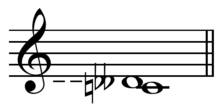

The diaschisma (or diacisma) is a small musical interval defined as the difference between three octaves and four perfect fifths plus two major thirds (in just intonation). It can be represented by the ratio 2048:2025[1] and is about 19.5 cents. The use of the name diaschisma for this interval is due to Helmholtz; earlier Rameau had called that interval a "diminished comma" or comma minor.
A diaschisma is the difference between a schisma and a syntonic comma,[2] as well as the difference between the greater chromatic semitone (135:128 = 92.18 cents) and the just minor second (16:15 = 111.73 cents).[3] Medieval theorists Boethius and Tinctoris described the diaschisma as one-half of the Pythagorean minor second, or 256/243, which would make the other half either 25/24 (70.67 cents) or about 45 cents. The diaschisma may be approximated by 89/88, 19.56 cents.

Tempering out the diaschisma, in the modern meaning of the term, leads to a diaschismic temperament. The diaschisma is tempered out in the usual system of 12 equal temperament; in fact, 12 equal temperament can be characterized as the 5-limit temperament that tempers out both the syntonic comma of 81/80 and the diaschisma. However, it is possible to improve the tuning a good deal over that of 12-et and still temper out the diaschisma; the equal temperaments with 22, 34 and 46 notes all temper it out.
See also
[edit]References
[edit]- ^ Haluska, Jan (2003). The Mathematical Theory of Tone Systems, p.xxviii. ISBN 0-8247-4714-3. Diaschisma.
- ^ "Diaschisma", Merriam-Webster.com.
- ^ (1897). Columbian cyclopedia, Volume 9, np. Garretson, Cox & Company. pre-ISBN.
Well, that’s interesting to know that Psilotum nudum are known as whisk ferns. Psilotum nudum is the commoner species of the two. While the P. flaccidum is a rare species and is found in the tropical islands. Both the species are usually epiphytic in habit and grow upon tree ferns. These species may also be terrestrial and grow in humus or in the crevices of the rocks.
View the detailed Guide of Psilotum nudum: Detailed Study Of Psilotum Nudum (Whisk Fern), Classification, Anatomy, Reproduction